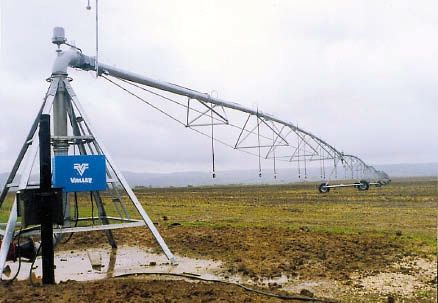Precision agriculture technology can refine irrigation practices
By Gord Gilmour
| 4 min read

The newest variable-rate irrigation technology takes field maps and layers information on them to create a multi-dimensional database. File photo
Variable-rate irrigation systems aren’t in Manitoba fields yet, but it’s likely just a matter of time
A few short years ago, the height of sophistication when it came to implementing a potato irrigation plan was a few soil sensors sprinkled around the field. They would alert the grower that soil moisture was falling and yield and quality would start to suffer.
The grower would then have to head out to the field and start the pivot turning, waiting for the soil moisture to reach acceptable levels again.
Like most last-generation soil-monitoring and testing solutions, however, they represented a one-size-fits-all approach to a much more complex problem. Soil variability throughout the field meant that while the area around the sensor might be getting dry, other parts of the field were almost certainly still soaking wet.
The end result was better than guesstimating water applications based on the feel and appearance of the soil, but it still wasn’t perfect. A more precise solution has begun to appear on pivots throughout North America over the past couple seasons — variable-rate irrigation.
Taking a page from the larger precision agriculture playbook, variable-rate irrigation uses complex field maps to create a prescription that addresses field variability. It relies on a sophisticated solenoid-driven system that varies water flow from nozzle to nozzle, depending on the field map.
Jeff Bronsch, president and CEO of Sunrise Ag, of Taber, Alta., says just a few of these high-tech systems are out in fields today, but he told this winter’s Manitoba Potato Production Days meeting he’s expecting that number to grow quickly as the benefits become apparent to producers.
“Understanding the soil/water relationship is paramount,” Bronsch told the meeting. “Not every sandy clay loam is created equally.”
He used the example of two soils that are both considered sandy loams. The first has 77 per cent sand and 21 per cent clay, while the second has 46 per cent sand and 34 per cent clay. The first can hold 35 mm of water in the top 30 cm of the soil profile, while the second can hold 52 mm. Bronsch conceded that he wasn’t telling growers anything new, since everyone instinctively understands this variability exists. However, until recently there was no technology available to apply different irrigation rates.
The newest variable-rate irrigation technology takes field maps and layers information on them, each one contributing to a sophisticated map that understands what goes on below the soil surface. Typical ‘layers’ include elevation, soil type and texture, aerial images taken of bare soil or during early spring and any existing yield maps.
This information is then fed into a system that manages the pivots that apply both water and fertigation applications according to the prescription generated from this map, saving water, energy and other inputs, which lowers production costs. One Manitoba irrigation specialist says there’s lots of interest in the potato and horticulture industry in this technology, but that the business case is stronger in other jurisdictions. Professor Sri Ranjan, of the University of Manitoba, says growers here enjoy a couple realities others don’t.
“We don’t pay for water here in Manitoba, unlike places like Oklahoma and Nebraska, for example,” Ranjan says. “That makes the economic case for this technology a bit harder to justify.” They’re also typically just providing a few inches of supplemental irrigation a season, rather than having to provide the lion’s share of the crop’s moisture requirements.
That’s not to say it doesn’t have a fit, however, since saving resources and limiting production costs are only part of the equation. There’s also the crucial question of crop quality and consistency, something the province’s potato processors insist upon and reward growers for achieving. The more evenly water is fed to the crop, the less defects and incidents of disease and the more uniform tuber size becomes.
“This is the area where these systems start to make sense for Manitoba,” Ranjan says. “The province’s potato processors really like to see growers have irrigation systems because they translate into better-quality, more consistent, tubers.”
He says potato buyers aren’t insisting on these upgraded systems yet, and in fact he isn’t aware of any in operation yet in Manitoba.
“I obviously don’t know about every irrigation system in the province, but I have yet to hear of a variable-rate system that’s in use here,” Ranjan says.
He’s expecting that to change in coming seasons however, as the technology proves itself.
“This is proven technology that’s field ready now,” Ranjan says. “It’s widely used in other areas and is seen to be very effective.”
This article appeared in the May 1, 2014 edition of the Manitoba Co-operator


